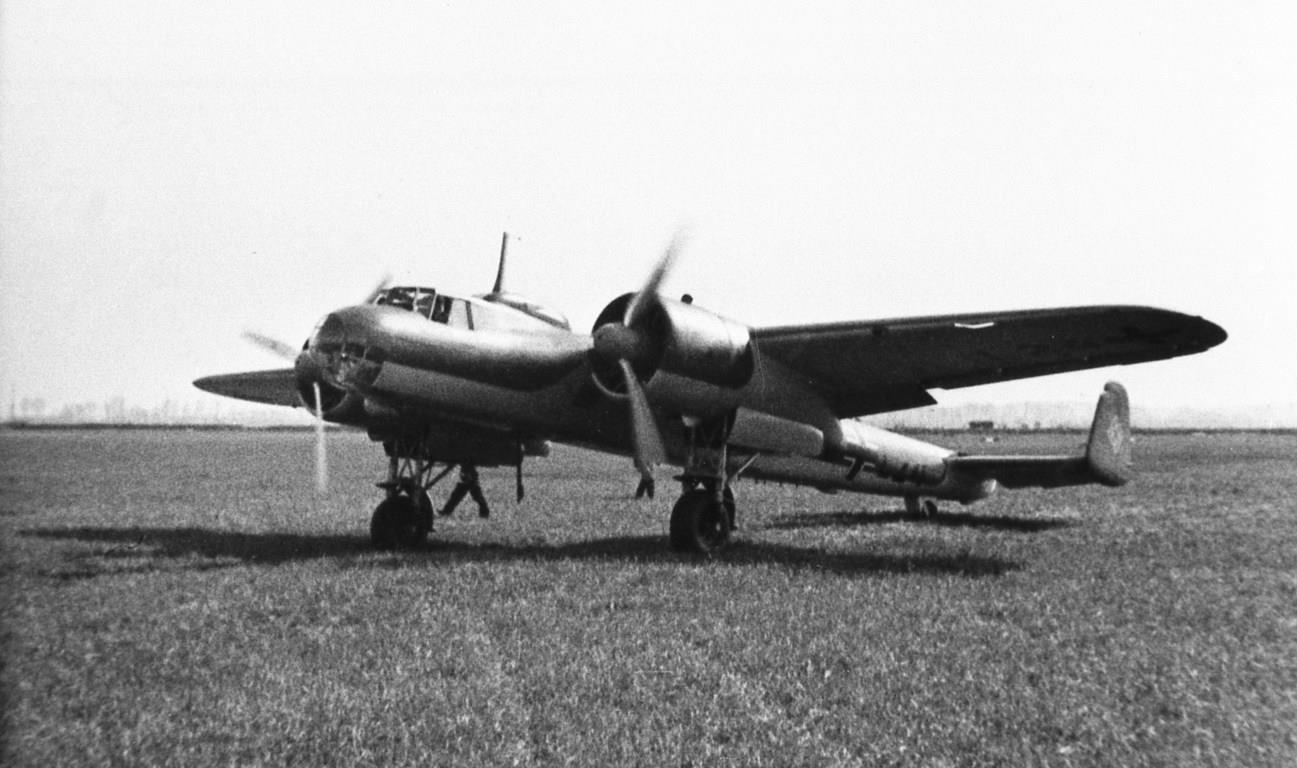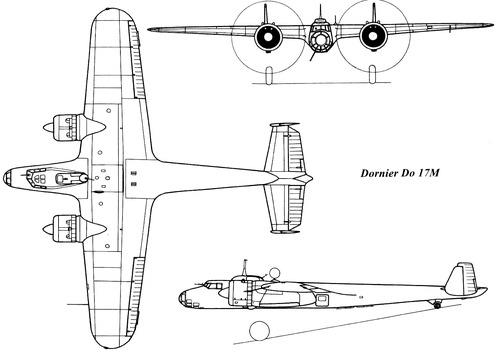| Type |
3-seat medium bomber (pilot, pilot in command, radio operator) |
| Engine |
2 BMW Bramo 323A with 3-bladed VDM variable pitch propellers, dia 3,6 m |
| Dimensions |
Length 16,0 m , height 4,62 m , span 18,0 m , wing area 55,0 m2 , |
| Weights |
Empty 5610 kg, loaded 8185 kg , max. take off weight fuel 2 x 700 l |
| Performance |
Max.. speed 365 km/h sea level , , range 1375 km at sea level endurance , service ceiling 6700 m , climb to 5000 m 19 min. |
| Armament |
2 - 3 7.92-mm MG 15 machine guns, internal bomb load, kg 500 - max. 750 kg |
Despite its success, owing to shortages in the supply of the Daimler-Benz engine, the production Do 17M was fitted with the Bramo 323 engine, with the corresponding reconnaissance aircraft, the Do 17P, being powered by BMW 132Ns to give better range.
The supply of the DB 600 remained extremely limited as production was soon switched over to the fuel-injected DB 601, which was reserved for the Messerschmitt Bf 109 and Messerschmitt Bf 110 fighters. Therefore, production versions of the basic Do 17M model airframe were fitted with the new Bramo 323A-1 Fafnir engines of 670 kW (900 hp), which gave reasonable performance and raised the bomb load to 1,000 kg . The resulting Do 17 M-1 was produced in small numbers and operated until 1941.
The prototypes for the M-1 series were Do 17M V1 (Werk Nr 691) and Do 17M V2 (Werk Nr 692) which were tested with bomb loads of a medium bomber. The third prototype, Do 17M V3 was evaluated as a fast bomber. The M V1 was fitted with two Daimler Benz DB 601 inline engines while the M V2 and M V3 had the Bramo 323 A and D respectively.
The Do 17 M-1 started its service as a medium bomber and was able to carry 1,000 kg of bombs. It was equipped with two air-cooled Bramo 323 A-1 or A-2. The defensive armament consisted of two, and later three, MG 15 machine guns. The first was operated in an A-Stand pod operated by the navigator through the windshield. The position was allocated 370 rounds of ammunition. The rearward firing B-Stand was operated by the radio operator and allocated 750 rounds. The rear position in the lower fuselage was allocated 375 rounds in a C-Stand pod. The Do 17M could carry a bomb load of either 20 SC50 50 kg or two SC250 250 kg bombs or 10 SC50 and a single SC250 bomb. The speed of the M was superior to that of the E variant. The Do 17M could reach 420 km/h ) at altitudes of 3,500 m and could achieve a maximum service ceiling of 5,790 m and a range of 1,570 km





Do 17 M-1. This followed the Yugoslav aircraft. With 1,000 HP Bramo Fafnir 323A-1 radial powerplants. It was the bomber version, with the longer bomb bay and an additional MG 15. It was fitted with devices for blind night flights and photographic equipment for reconnaissance.
The L version would not be able to enter production with the DB 600 (Daimler-Benz 600) engine due to its use in the Bf 109, and the Bramo engine was quite thirsty and left the M models with too short a range for reconnaissance use. The 865 HP BMW 132N radial engines were selected because they had a lower fuel consumption and a consequent better range.
The Do 17 L-0 and Do 17 M-0 were developed in parallel as replacements for the E and F, the L being the reconnaissance version and the M a bomber version. Two L and one M versions were built as prototypes. The first prototype of the revised version, the Do 17M V1 (D-ABVD) was powered by two DB 600s, and demonstrated impressive performance, including a top speed of 425 km/h (264 mph). At the International Military Aircraft Competition in Zurich, Switzerland in 1937, the Dornier Do 17M V1 proved to be a leader in its class and was faster than the fastest foreign fighter, the French Dewoitine D.510. The Do 17, along with the Messerschmitt Bf 109, won many awards, demonstrating the prowess of German aviation design. However, due to a shortage in the supply of the Daimler-Benz engine, the production Do 17M was fitted with the Bramo 323 engine, with the matching reconnaissance aircraft, the Do 17P, being powered by BMW 132Ns to give better range.
Engine supplies were extremely limited as production was soon switched to the gasoline-injected 601 DB engines, which were reserved for the Messerschmitt Bf 109 and Messerschmitt Bf 110. Therefore production versions of the basic airframe, the Model 17M, were fitted with the new 670 kW (900 hp) Bramo 323A-1 Fafnir, which gave reasonable performance and a bomb load of 1,000 kg (2,200 lb). Both were fitted with the more powerful Daimler-Benz 600A engines, giving around 1,000 hp (746 kW). The same engine powered the Do 17 V8 which also won the speed trials at the International Military Aircraft Competition in Zurich, Switzerland. The Dornier Do 17M V1 also entered the competition in 1937, proving to be faster than the fastest foreign fighter, the French Dewoitine D.510. Two L and one M versions were built as prototypes. The first prototype of the revised version, the Do 17M V1 (D-ABVD) was powered by either Daimler-Benz 600 or DB 601 gasoline-injected engines, and demonstrated impressive performance, including a top speed of 425 km/h (264 mph). The Do 17, along with the Messerschmitt Bf 109, won many awards, demonstrating the design prowess of German aviation. However, due to a shortage of the Daimler-Benz 600 engine for the Messerschmitt Bf 109 and Messerschmitt Bf 110 fighters, the production Do 17M (bomber version with a 1,000 kg bomb load) was fitted with the 900 hp Bramo Fafnir 323A-1 engine, which gave reasonable performance, and the reconnaissance aircraft, the Do 17P, was powered by the 865 hp BMW 132N to give it greater range. The MG 15 armament was increased to give it forward and rearward firing capability, and these weapons could be operated by the pilot or the navigator/bombardier.
The Do 17M-1 began service as a medium bomber and was capable of carrying 1,000 kilograms of bombs. It was equipped with two air-cooled (air-cooled? forced-air?) Bramo 323s. Defensive armament consisted of two or three MG 15 machine guns. The first machine gun was operated by the navigator through the windshield. It was allocated 370 rounds of ammunition. The rear firing was operated by the radio operator and was allocated 750 rounds. The rear position on the underside of the fuselage was allocated 375 rounds. The Do 17M could carry a bomb load of either 20 50 kg (110 lb) SC50s or two 500 kg (1,100 lb) SC250s or 10 SC50 bombs and a single SC250 bomb. The speed of the M was superior to that of the E variant. The 17M could reach 420 km/h (250 mph) at an altitude of 3,500 m (11,500 ft) and could reach a maximum service ceiling of 5,790 m (19,000 ft) and a range of 850 nautical miles (1,570 km). The prototypes of the M-1 series were the MV1 (WRK No. 691) and MV2 (WRK No. 692), which were tested with medium bomber bomb loads. The third prototype, the MV3 was evaluated as a fast attacker. The MV1 was powered by two inline Daimler Benz DB 601 engines, while the MV2 and MV3 had the Bramo 323 A and D respectively. The Ministry of Aviation favoured widespread use of the 601 DB, but demand for the 601 in fighter aircraft and lack of production forced the use of the Bramo.
The Do 17 M-1 was produced in small numbers and served until 1941 when they were retired and sent to training units.
Demand for a reconnaissance aircraft based on the M-1 led to the development of the P-1 variant.








